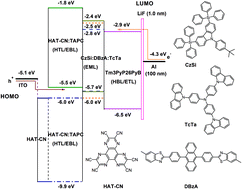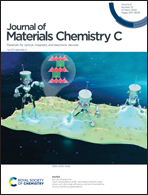Pure-blue fluorescent organic light-emitting diodes by co-doping a supplementary host material into a light-emitting layer as an electron transport ladder
Abstract
In this study, an efficient device design strategy in improving the performances of blue fluorescent electroluminescence was demonstrated by co-doping 9-(4-tert-butylphenyl)-3,6-bis(triphenylsilyl)-9H-carbazole (CzSi) into a light-emitting layer (EML) as an electron transport ladder. 9,10-Bis[4-(6-methylbenzothiazol-2-yl)phenyl]anthracene (DBzA) and 4,4′,4′′-tris(carbazol-9-yl)triphenylamine (TcTa) were utilized as the emitter and the main host material, respectively. Compared with the device without CzSi, the performances of the co-doped device were improved effectively because of the well-matched energy levels and excellent electron transport ability of CzSi, which facilitated the injection of electrons and thus balanced the distribution of carriers. The feasibility of this device design strategy was demonstrated by investigating single-carrier devices, transient electroluminescent (EL) spectra and normalized EL spectra. Finally, the optimal pure blue fluorescent device realized a maximum brightness, current efficiency, power efficiency and external quantum efficiency (EQE) of up to 28 009 cd m−2, 7.51 cd A−1, 7.60 lm W−1 and 6.8%, respectively. Even at a high brightness of 1000 cd m−2, current efficiency and EQE as high as 6.21 cd A−1 and 5.6%, respectively, can still be retained by the same device.



 Please wait while we load your content...
Please wait while we load your content...